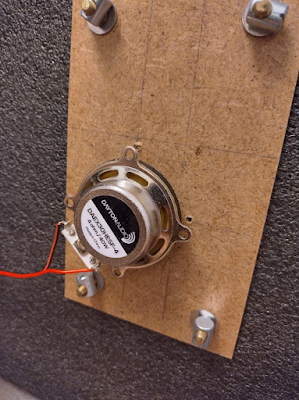DML speaker from Dayton Audio exciter
I got one pair of 40 watt exciters, Dayton Audio DAEX30HESF-4, with adhesive tapes (3M VHB) and tried them on the foam pad (36 x 46 x 7 cm) that came in the subwoofer package. The foam is very stiff and heavy for foam. The sound was surprisingly good, but the highs were muffled. I made a small layered structure, i.e. on top of the foam there is a smaller wood fiber board recycled from the packaging material (110 x 180 x 3 mm). Now the sound is already pretty good. I decided to glue the exciter with its adhesive tape to that wooden board and innovatively with furniture bolts (which I had left over from the disassembled furniture) to the foam with the aim of being able to remove the exciter from the larger foam if necessary, because the sticker can hardly withstand many removals. The exciter is attached to the 5:3 position of both the larger and smaller plate on both axles, as the big boys told me to. The leads are soldered on the exciter.
 |
| Exciter on wood fiber board. |
 |
| Pair of completed panels. |
I then drove this DML "beauty" with a class D mini amplifier, with a DIY battery pack (4x AA) and a step-up converter adjusted to 12 Volts (max 19 V for the amp input). I can't say about the battery life yet, but the speaker didn't sound very loud. Maybe increasing the voltage of the power supply could help, but then it affects the battery life, so I think the current voltage level is a sufficient compromise for my use. When I hold the panel in my hand, the bass goes really low and the treble is quite good, at least with techno and other electronic music. The manufacturer's FR measurement is therefore only indicative and the final result is completely dependent on the size and composition of the panel used. Measurements below.
 |
| Amplifier and a battery power source. |
The price for the speaker was really not very high and smaller model exciters are about 15 €/piece, so you can get a great, travel-friendly cabin set for a quite little money. In retrospect, I think that I should have bought a newer model which has a screwable mounting system, that is, the mounting pad is screwed to the panel and the exciter onto the mounting pad. That sticker that came with it hasn't come off yet, but that mounting system would allow for more reuse.
The screw holes of the exciter shown in the picture are not for fixing the panel (the cone is not screwed to the cabinet even in a normal speaker), I made a mistake when I tried it. The holes are for attaching an optional casing or cabinet. And nuts won't stay in those holes, they start moving when the exciter vibrates. There was no small enough lock nut on hand. Some people make these the main speakers in the first set, but I wouldn't go for that.
Measurements
And then some graphs. Microphone measurements were made with miniDSP SHD, NC400, REW, UMIK-1 and the DUT was placed on the corner of the sofa. Impedance was measured with my own impedance measuring device prototype and REW. If I remembered to put the smoothing, it's CTRL+SHIFT+8, that is 1/24 Oct. In the pictures, upside/downside means the upper side of the panel (where the exciter is attached) or the lower side. During the first measurement, I noticed that the panel to be measured rattled, so the volume has been slightly adjusted accordingly. Louder volume could have given better IMD graphs, but I didn't think it was worth the while.
SPL and Impedance
Below are the impedances of both DML individuals (exciter+panel) and the SPL of the other individual from both sides (top=lilac, bottom=violet):
4 Ohm nominal. Moderate spikes, the increase in impedance towards highs is actually greater than the spikes. The spikes are cabinet/panel specific.
The bass does go fairly low on this panel. There are separate bass shakers that are intended to be attached to a chair/sofa, such would certainly be a nice addition in the movie room.
Impulse Response
At this point everyone is probably most interested in IR from both sides:
Now these two graphs are not completely comparable, because the mic is placed in a slightly different position for the other measurement than directly in the middle. It cannot be helped. But this shows the most interesting thing, i.e. the direction of the pulse and some other timing horrors.
Distortion
It's high, and quite a bit too. It is worth noting that harmonic distortion multiples of 7-9 are exceeding the noise floor, which is rare for any decent loudspeaker nowadays. I did not display all lines, since it is difficult to read as it is. What's surprising, it doesn't sound that bad. I wonder if there is an explanation unknown to me for this.
Group Delay
There is a mystical 240 ms delay peak at 31.4 Hz, I don't know where that came from. Otherwise it's OK.
Waterfall
Surprisingly good. Even 20 Hz is not that bad. I bet it's harder to get such a short reverb with a normal subwoofer, at least in a room. Of course, this was a close-field measurement against the sofa cushions, so it corresponds to a room that is well damped with normal loudspeakers.
Intermodulation Distortion (IMD)
Intermodulation distortion, using REW generator test signal battery and with RTA function, 8 averages. As far as I remember, all measurements are from the top side of the panel.
The distortion would show better if the measurement had a louder SPL, but it seems that there is still enough information here.



















Comments
Post a Comment